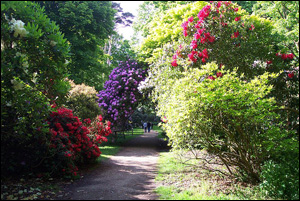 One of the best investments a homeowner can make is to plant a tree. Not only will the tree provide shade that cools the house in the summer heat, but it will also add value to the property if planted in the right place.
One of the best investments a homeowner can make is to plant a tree. Not only will the tree provide shade that cools the house in the summer heat, but it will also add value to the property if planted in the right place.
Before choosing or planting any tree, consider the mature height of the tree or shrub in relation to the scale of your yard. Give them plenty of room to grow by spacing them a good distance from the house, sidewalks, or other trees. If they are large-growing trees, do not plant them under utility lines. Before digging, locate all underground utility lines.
Trees or shrubs ready for planting will be sold in one of three ways. Bare-root trees are more economical to buy but are more difficult to get started in your landscape and should only be planted in the spring.
Many trees, especially evergreens and large trees, are balled and burlapped after they are dug up in the nursery and do best planted in the spring or fall. Smaller trees and shrubs sold in containers can be planted almost any time of year when the soil is not frozen, but planting them in the spring gives the trees the most time to get established before winter.
When digging a hole for a tree, remember to dig “a dollar-size hole for a dime-size root system.” Avoid digging the hole too deep – it should allow the top of the root system to sit level or slightly higher than the surrounding ground. The tree also needs a firm support below to keep it from settling.
Tree-Planting Tips
Carry a potted tree by the container or root mass, not by the trunk.
Inspect the tree’s root system before planting. If the roots are circling the root mass, take a sharp knife and make four or five vertical cuts along the side of the root mass to cut apart the circling roots. This will help the tree get established.
After planting, give the tree plenty of water. Add mulch around the tree to help conserve moisture and keep turf and weeds at bay.
Wrap the tree trunks of young trees to help prevent sunscald over the winter, especially on thin-barked species, such as ash, crabapple, linden, and maple.
Dwarf Conifers
A conifer is a cone-bearing plant; many are evergreen. Dwarf conifers are those that never reach the height typical of their species, whether it be a spruce, juniper, or fir.
Dwarf conifers are great planted in small landscapes and near the house because they grow slowly and stay small. These conifers may grow only 1 to 1-1/2 inches each year.
They also may not have the same form as the original species. Dwarf conifers may be a pyramidal or Christmas tree shape, such as a dwarf Alberta spruce; or a globe shape, such as a dwarf mugo pine, that will grow only 4 feet tall and 4 to 6 feet wide. Some varieties of creeping juniper grow only 6 inches tall but spread 4 to 6 feet like a ground cover.
Two dwarf conifers that make great accent plants are the compact concolor fir, notable for its soft, gray-blue needles, and the mound-shape arborvitae with its golden foliage.
Before planting, consider the light each conifer will receive to get the most from its color variations. Silver or blue conifers maintain their color better in partial shade. Yellow and golden species require full sun for best color development.
Always purchase dwarf conifers as container-grown or balled-and-burlapped plants. They live in association with fungi that surround the roots and assist the plants in obtaining nutrients from the soil.
Since these conifers grow so slowly, buy plants as big as your budget will allow.
About the author: Samet Yahya Bilir is a toy collector who writes about toys and games at his blog. You can check his website for toy news, pictures, videos, and reviews, such as army toy tanks and toy trains sets.
Credits: Photo courtesy of Wikimedia Commons.